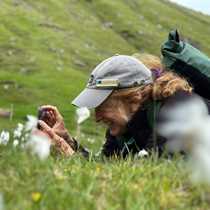Astoria
Anxious eyes peered from cabin doorways and half fogged windows. It was raining outside, or at the very least, the mist was exuberant. Such can be mornings in Astoria, perched on a peninsula so close to the Pacific Ocean that she commonly wakes shrouded in a misty gray bathrobe. As the morning progressed, the rain and mist lightened and a glow from the east bathed the city in suggestions of shadow and contrast, the sun was going to shine.
The Columbia River Maritime offered us a refuge from the temperamental weather. Storm tossed seas created a watery graveyard for hundreds of vessels over the last few hundred years, creating at the same time a plethora of flotsam for display and interpretive opportunity at the museum.
Entering the forest at Fort Clatsop, the heaving forest duff told us of the emergence of mushrooms. These colorful, globular, convoluted and platter sized sculptures hoisted themselves above ground, all with the design and intent to disseminate spores and perpetuate the species.
How much could you find in this forest if you thoroughly searched one square foot? It would depend on your perspective. Standing upright and tall, a scan of the trees and shrubs would reveal spruce, cedar, western hemlock, salal, red and evergreen huckleberry and sword ferns. Meriwether Lewis would never stop at that. The smallest deviation of leaf shape or flower form unfamiliar to him would instantly have him on his knees, meticulously and methodically collecting a specimen for preservation.
With the rhythm of an undulating sea beneath our feet, we sailed west to see for ourselves the Pacific Ocean. We concurred with Clark’s notation made in 1805; it did not look so pacific beyond the breakers. Parallel to the rivers surface flew sporadic flocks of brown pelicans, their lines rising and falling in cadence with the waves.
Hopefully, in this past week we have broadened our perspectives. With so many facets of the Lewis and Clark expedition to explore, we have barely touched the tip of the iceberg. Perhaps with our expanded outlook, we may see in something as simple as this berry-filled bush many different components; the coming of fall, impending migrations, a ready avian meal, or perhaps even the Oregon state flower. There are galaxies still to explore, some right under our own two feet. We wish an informative and enjoyable journey to all.
Anxious eyes peered from cabin doorways and half fogged windows. It was raining outside, or at the very least, the mist was exuberant. Such can be mornings in Astoria, perched on a peninsula so close to the Pacific Ocean that she commonly wakes shrouded in a misty gray bathrobe. As the morning progressed, the rain and mist lightened and a glow from the east bathed the city in suggestions of shadow and contrast, the sun was going to shine.
The Columbia River Maritime offered us a refuge from the temperamental weather. Storm tossed seas created a watery graveyard for hundreds of vessels over the last few hundred years, creating at the same time a plethora of flotsam for display and interpretive opportunity at the museum.
Entering the forest at Fort Clatsop, the heaving forest duff told us of the emergence of mushrooms. These colorful, globular, convoluted and platter sized sculptures hoisted themselves above ground, all with the design and intent to disseminate spores and perpetuate the species.
How much could you find in this forest if you thoroughly searched one square foot? It would depend on your perspective. Standing upright and tall, a scan of the trees and shrubs would reveal spruce, cedar, western hemlock, salal, red and evergreen huckleberry and sword ferns. Meriwether Lewis would never stop at that. The smallest deviation of leaf shape or flower form unfamiliar to him would instantly have him on his knees, meticulously and methodically collecting a specimen for preservation.
With the rhythm of an undulating sea beneath our feet, we sailed west to see for ourselves the Pacific Ocean. We concurred with Clark’s notation made in 1805; it did not look so pacific beyond the breakers. Parallel to the rivers surface flew sporadic flocks of brown pelicans, their lines rising and falling in cadence with the waves.
Hopefully, in this past week we have broadened our perspectives. With so many facets of the Lewis and Clark expedition to explore, we have barely touched the tip of the iceberg. Perhaps with our expanded outlook, we may see in something as simple as this berry-filled bush many different components; the coming of fall, impending migrations, a ready avian meal, or perhaps even the Oregon state flower. There are galaxies still to explore, some right under our own two feet. We wish an informative and enjoyable journey to all.




